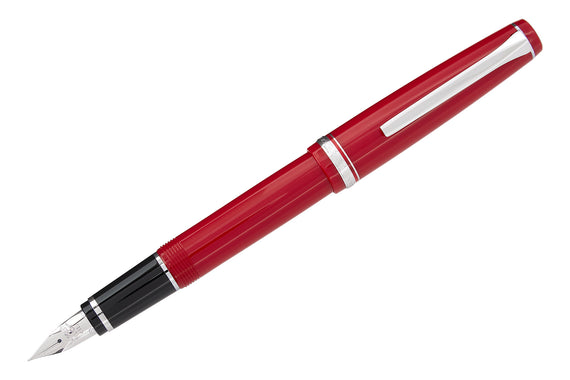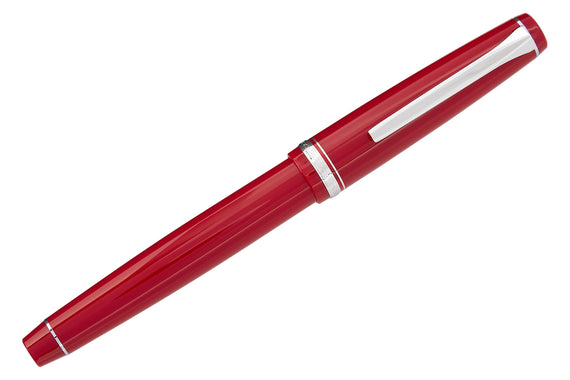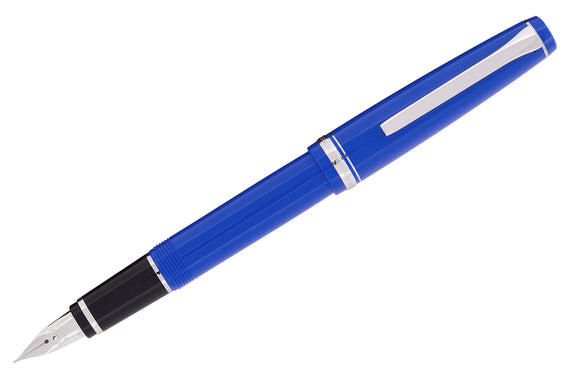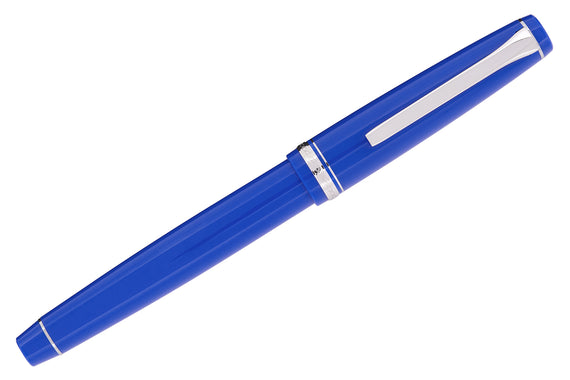Pilot Falcon (FA) Nibs Explained
If you’re familiar with Pilot fountain pens, you’ve probably heard of the Falcon. However, Pilot has several products with Falcon in the name, and my goal is to explain them all to you so you’re as informed as possible when exploring options or making a pen purchase.
To quickly summarize, there is a Pilot pen model called the Falcon with a nib unique to that pen, and then there’s a different nib called the Falcon, abbreviated as the FA, which is available on a few different Pilot pen models. While both are associated with the name Falcon and have some properties of softness and line variation in their writing, these are entirely different nibs offered on different pens. Both are awesome and worth learning about!
In this blog & video, when I mention the Falcon, I’m referring to the Pilot fountain pen model and its corresponding nib. When discussing the FA nib on Pilot pens, I usually call it FA instead of Falcon to distinguish it from the Pilot Falcon pen model. This aligns with how most of the pen community discusses these, but it's good to be aware of the potential confusion. This way, you can be certain of the specific pen or nib being addressed when you encounter it.
Pilot Falcon Fountain Pens
Let’s start with the Pilot Falcon pen, as it’s the most straightforward to understand. Pilot has been offering this model for years, previously under the Namiki name alongside their higher-end maki-e pens. It’s been branded as Pilot for just under a decade now, but it’s possible you could come across some old posts or videos online referring to the Namiki Falcon, even on our YouTube channel if you go back far enough. Just know that today’s Falcons are the exact same pens, but with the Pilot branding instead of Namiki. It’s also known as the Elabo in Japan, but it’s called the Falcon elsewhere, including in the U.S.
The Falcon is a fantastic pen—relatively compact and very light, yet it still feels solidly built. It has a flat top with simple lines, a couple of nice trim rings, and a very classic look. I particularly love the look of the clip on this pen, which is unique to the Falcon in Pilot’s lineup. It’s offered in four regular colors: black, red, purple, and blue, all with rhodium trim, though you can also get the black one with gold trim.
There’s another version called the Metal Falcon, which uses the exact same nib and feed setup as the resin version, but it’s slightly larger and heavier.
While the Falcon is a beautiful pen in its own right, the main attraction is the way it writes. The nib on this pen is very distinctive. It makes sense why they call it the Falcon because the nib looks somewhat like a beak, with the nib tines raised higher than the base of the nib. I can’t think of another nib with this shape. Purportedly, the shape of the nib assists in the softness of the nib tines. I’m not sure exactly why, but I can say it writes really well. I also think the feed, which is smooth and swoops underneath the nib, looks really appealing.
Pilot’s gold nibs are usually pretty springy, but the Falcon takes it to another level with its designated “soft” nib. Pilot doesn’t offer many soft-writing nibs on their pens, but the Falcon has always had soft nibs and only soft nibs. I always try to be careful when using the word “flex” when talking about nibs, especially if the manufacturer doesn’t call a nib flexible. Pilot doesn’t call this flexible; it is a “soft” nib. However, it’s a soft nib that can produce some line variation if you press down, so it often gets compared to other flex nibs. I think it’s suitable for occasional flexing of the tines, but you don’t want to overdo it. If you want true flexibility, you’ll need to go to a nib specialist who modifies nibs, as this one has a lot of potential as a modified nib if that’s something you’re interested in.
Pilot Falcons are made in soft extra-fine, soft fine, soft medium, and soft broad, though we don’t regularly stock the soft broad anymore due to lower demand. The soft extra-fine and soft fine are really the bread and butter of this pen, likely because the thinner nib sizes allow for more dramatic line variation. Pilot does such a great job on their finer nibs. The EF will have a bit of drag but gives you the thinnest line. I personally like the fine the most, as it still produces a very fine line but feels noticeably smoother on the page. It really just depends on your preference.
This higher-priced pen is definitely an investment, but it’s still very much on the affordable end for pens with gold nibs, and this one makes a significant difference in how it writes because of that nib.
Pilot FA Nib

Now that we’ve covered the Pilot Falcon and its intense, beaky nib of goodness, let’s discuss its cousin, the Pilot FA nib. When you see a Pilot Falcon next to an FA nib on a pen like the Custom 743, you can immediately see they’re visually strikingly different. The FA nib does not have the beak-like bend; it’s flat all the way down, just like most other nibs. However, it has some distinctive cutouts on the sides.
These cutouts aren’t just for aesthetics; they decrease the stiffness of the nib, a technique also used on other nibs like Conklin or Monteverde Omniflex nibs and JoWo flex nibs, such as our Goulet flex nibs. These comparison nibs are all stainless steel, so when this technique is applied to a gold nib like the FA, the effect is more pronounced. The idea behind these cutouts is that less metal allows for more flexibility of the tines, giving you a softness similar to the soft nib of the Pilot Falcon. This is where the two nibs often get mixed up because most people talk about both in terms of their flexibility and line variation, which is a special feature they both offer.

The FA nib is only one size, which I find pretty comparable to the Pilot Falcon soft fine nib. In terms of the end result on the page, especially regarding line variation when writing with pressure, the FA and Falcon soft fine are almost indistinguishable. However, the writing experience feels different. Due to the way the tipping on the nibs is ground, the FA nib writes best in a more upright position, around a 50-60 degree angle from the writing surface, higher than the Falcon. I personally write with a lower angle, so the FA nib requires some adjustment for me to hold it steeper than I naturally would to achieve the desired line variation.
Here in the US, we’ve had the Falcon pen model for quite some time, but the FA nib has only been available here for a few years. The FA nib was first available on the Custom Heritage 912, which uses Pilot’s #10 size nib—sort of in-between a German #5 and #6 nib from Bock or JoWo. Recently, Pilot offered the Custom 743 with the FA nib, which has Pilot’s #15 size nib, roughly the size of a Bock or JoWo #6.


Other than the overall physical size, I can’t visually see much difference between the two sizes of the FA nib, but I find the #10 nib on the Custom Heritage 912 FA nib to be a little finickier about the writing angle—it wants to be way up high. I feel like the #15 nib on the Custom 743 is more forgiving in this aspect; maybe it’s the slightly longer tines. It’s not a big deal—it’s just something I noticed when using them both. If you write with a lower pen angle and all else is equal to you, consider the Custom 743 FA nib over the Custom Heritage 912.
 There you have it—the differences between the Pilot Falcon fountain pen and the Pilot Falcon (FA) nib. If you have any questions, please use this blog post to study up on the Falcon or FA nibs. As usual, you can always ask questions by reaching out to our Customer Care team at Goulet Pens. Write on!
There you have it—the differences between the Pilot Falcon fountain pen and the Pilot Falcon (FA) nib. If you have any questions, please use this blog post to study up on the Falcon or FA nibs. As usual, you can always ask questions by reaching out to our Customer Care team at Goulet Pens. Write on!



































